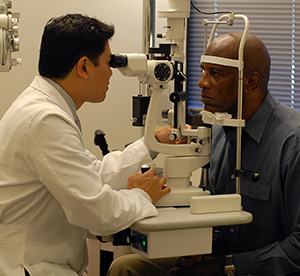Understanding computer vision syndrome
Computer vision syndrome (CVS) is a group of eye- and vision-related problems. These problems can include eyes that are dry, red, itchy, or tearing. Your eyes may feel tired. You may not be able to focus well. CVS problems are the result of prolonged use of a computer, e-reader, tablet, or smartphone. CVS is very common. It affects both children and adults.
Causes of computer vision syndrome
Reading text on a screen is harder for the eyes than reading printed text. This is why working on a computer can cause eye problems, but reading a book may not. People also tend to blink less when using a computer than when reading printed text. Less blinking can cause dry eyes, which can also contribute to computer vision syndrome.
Many factors can lead to computer vision syndrome, such as:
-
Spending several hours a day at the computer
-
Having vision problems (even minor ones) not corrected with lenses
-
Wearing glasses not suitable for viewing your computer screen
-
Having poor posture while using the computer
-
Using the computer in poor lighting
-
Having glare from the computer screen
-
Sitting too close to the screen
-
Positioning the screen at a wrong angle
-
Not taking breaks while you are working
-
Using an older-style monitor instead of a flat-screen monitor
Dry eye and CVS
Dry eye is a condition where you don’t make enough tears to wet the eye, or your tears evaporate too quickly. If you have dry eye, this can make CVS worse or more likely to occur. Dry eye is more common in women, and with aging. Some medicines and health problems make dry eye more likely. For example, using antihistamines may lead to dry eye. Thyroid disease and some autoimmune diseases may also lead to dry eye.
Symptoms of computer vision syndrome
Computer vision syndrome can cause symptoms such as:
-
Tired eyes
-
Eye discomfort
-
Dry eye
-
Red eyes
-
Eye tearing
-
Itchy eyes
-
Blurred vision
-
Double vision
-
Headaches
Most of these symptoms last a short time and lessen or go away when you stop using your computer. In some cases, symptoms may last for a longer time after using a computer.
Symptoms may be mild to severe. This depends on how long you use the computer and other eye problems you may have. Symptoms can get worse without treatment.
Computer use can also lead to neck and shoulder pain. This is often because you may have poor posture when using your computer. Some healthcare providers also consider these symptoms of CVS.
Diagnosing computer vision syndrome

An eye care provider diagnoses CVS. They will ask about your symptoms and your health history. You’ll be given an eye exam. You may have tests to check the sharpness of your vision and how well your eyes focus and work together. Eye drops may be used to enlarge (dilate) your irises. This lets the eye care provider see into your eye. They may use a tool called an ophthalmoscope to look at the back of your eye. You may also have blood tests. These check for health problems that can cause dry eye and lead to CVS.
Treating computer vision syndrome
Treatment includes creating a better work environment.
- Rest your eyes at least 15 minutes after each 2 hours of computer or digital device use.
- Every 20 minutes, look into the distance at least 20 feet away from the computer or digital device. Do this for at least 20 seconds.
- Enlarge the text on your computer screen or digital device.
- Reduce glare from the light sources in your environment.
- Think about using a screen glare filter.
- Place your screen so that the center of it is about 4 to 5 inches below eye level (about 15 to 20 degrees from the horizontal).
- Place your screen about 20 to 28 inches from your eye (about arm's length).
- Remember to blink often.
- Fix your chair height so your feet can rest comfortably on the floor. Don’t slump over the computer screen.